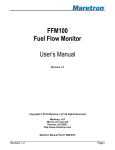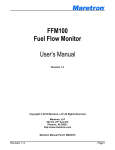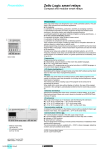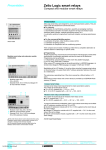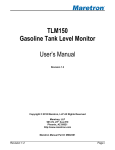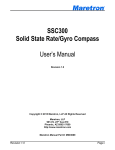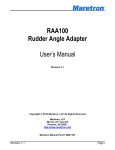Download Maretron FFM100 User`s manual
Transcript
Installation Instructions M4ARP-2R-E8 Fuel Flow Sensor WARNING NEVER disassemble the fuel flow sensor, except to remove the pulser cap, if necessary, in order to electrically connect the sensor to the FFM100. The sensor is factory sealed, and disassembly will void the product warranty. If you feel that the sensor is not functioning correctly, please contact Maretron Technical Support. Operating Principle When fluid passes through the sensor, the rotors turn, as shown in the figure on the right. Magnets which are located in the rotors will pass across sensors in the sensor circuit board. Pulses from these sensors are transmitted to the FFM100 which performs flow rate calculations based on the received pulses. Instructions Please follow these instructions to connect the M4ARP-2R-E8 fuel flow sensor to the NMEA 2000® network via a Maretron FFM100 Fuel Flow Monitor. 1. The fuel flow sensors are compatible with fuel, lubricating oil, hydraulic fluid, or other clean petroleum based products and should not be used with any other fluid types. 2. The fuel flow sensor contains shafts on which the oval rotors spin. The fuel flow sensor must be mounted so that these rotor shafts are always in a horizontal plane (parallel with the ground or water surface). The rotor shafts are parallel to the screws attaching the sensor cap to the sensor base, so ensure that these screws are in a horizontal plane. Please refer to Figure 1 below for examples of correct and incorrect orientations. 9 U 9 Figure 1 - Correct and Incorrect Mounting Orientations 3. To prevent damage from dirt or foreign matter, it is required that either 1) a diesel fuel filter capable of filtering out 75 micron particles or 2) a Y or basket type 60 mesh strainer be installed as close as possible to the inlet side of the sensor. 4. Install so that the direction of the “FLOW” arrows on the sensor label matches the direction of fuel flow. 5. The M4ARP-2R-E8 fuel flow sensor accessory for the FFM100 is fitted with 1/2” NPT female threads. 6. Use a liquid thread sealant on all pipe threads. Do NOT use Teflon tape. The fittings should be tightened hand tight, then a further ½ to 1 turn. Do not over tighten. 7. Extreme care must be taken when installing the sensor. Pipe strain or over tightening sensor connections can cause sensor damage. 8. To prevent damage to the sensor from entrapped air during initial commissioning or after maintenance, slowly fill the system with fuel (this will prevent damage caused by air purge). Failure to do this could damage the sensor. NEVER blow or send compressed air through the sensor as this may over rev and damage the sensor. 9. The sensor is supplied with a 10’ cable which is pre-installed to the sensor using a waterproof cable gland. If you are using this cable, please skip forward to step 11. If you are using your own cable, cable gland, or waterproof conduit, please go to step 10. 10. (Optional – only if using your own cable, cable gland, or conduit) Remove the pulser cap by removing the pulser cap mounting screws, and install a waterproof cable gland or waterproof conduit to the ½” female NPT fitting on the pulser cap. Please refer to Figure 4 on the reverse side for details. Route a six-conductor cable into the sensor cap and connect the conductors to the terminal strip on the printed circuit board mounted underneath the pulser cap. Do NOT remove the printed circuit board from the sensor. Replace the pulser cap (which can be replaced in any orientation) and secure with the pulser cap mounting screws. 11. Connect the other end of the cable to the corresponding terminals on the appropriate free pressure monitoring channel on an FFM100. Please refer to Figure 2 below for details (the wire colors in the figure are those of the supplied cable). 12. Use a Maretron DSM250 display (firmware 1.4.12 or higher), Maretron N2KAnalyzer software, or other Maretron display product capable of configuring the FFM100 to configure the connected channel. Please refer to the FFM100 User’s Manual for configuration details. Be sure to program the FFM100 with the K factor printed on the fuel flow sensor. 13. Supply Power to the NMEA 2000 network and verify that the flow channel indicates a valid flow rate and temperature reading. Red Black Orange Blue Green White Fluid Flow Sensor Pin 1 2 3 4 5 6 FFM100 Channel 0 Pin 1 2 3 4 5 6 FFM100 Channel 1 Pin 7 8 9 10 11 12 Red Black Orange Blue Green White 1 6 FFM100 Screw Terminals 3 4 5 6 7 8 9 10 11 12 Fluid Flow Sensor Pins A0 B0 C0 T0 P1 G1 A1 B1 C1 T1 2 P0 G0 1 FFM100 Channel 0 Pins FFM100 Channel 1 Pins Figure 2 – Fuel Flow Sensor Connection Diagram Copyright © 2011 Maretron, LLP All Rights Reserved P/N: M003023 Rev.1.0 12/11 Figure 3 - Fuel Flow Sensor Mechanical Drawing Fuel Flow Sensor Specifications Flow Range Nominal K Factor 180 LPH to 1500 LPH 112 pulses/L (424 pulses/Gal) (48 GPH to 396 GPH) Specification Operating Temperature Construction Port Size Accuracy % Reading Maximum Viscosity Maximum Operating Pressure Strainer Size Weight Dimensions Pulser Cap Mounting Screws Pulser Cap Value -10°C to 80°C (14°F to 186°F) Meter Body and Cap: Aluminum 601-T6 O-Ring: Viton Magnet Housings: Stainless steel 316L Shafts: Stainless Steel 316L Rotors: PPS Ryton BR42B Grade ½” NPT Female ± 0.25% (With K factor on sensor entered into FFM100) Sensor Body 1000 cPs 55 Bar (800 PSI) 60 Mesh (If not already installed after fuel filter) 907g (32.0 oz) 100 x 96 x 105 mm (3.94 x 3.78 x 4.13 in.) Figure 4 – Pulser Cap Removal For installation support, please contact: Maretron, LLP 9014 N. 23rd Ave #10 Phoenix, AZ 85021-7850 Telephone: (+1) 866-550-9100 E-mail: [email protected] Web: http://www.maretron.com Copyright © 2011 Maretron, LLP All Rights Reserved P/N: M003023 Rev.1.0 12/11



